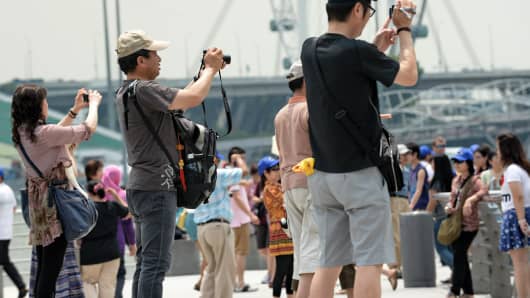Singapore, a hot spot for tourism in Southeast Asia, may begin to feel the heat of the currency turmoil afflicting neighboring economies as the cost for regional visitors to vacation in the island nation skyrockets.
The Indonesian rupiah, Malaysian ringgit and Indian rupee have tumbled between 4 and 14 percent against the Singapore dollar over the past two months, translating into higher holiday costs – from accommodation to food and entertainment – for inbound tourists.
(Read more: Singapore dollar: the next currency to fall?)
"There would be a huge impact on the tourism sector and economy if the currencies in those countries continue to decline sharply," said Song Seng Wun, economist at CIMB. Singapore has several links with regional economies as its tourism, property, wealth management and export sectors are tied to the prosperity of its neighbors.
"Singapore hotel rooms are not cheap, so if the Indonesian rupiah has fallen sharply against the Singapore dollar then that effectively leads to a cut in spending," Song added. However, he noted that the impact has been marginal thus far. "Tourists are still coming but they do complain, if my family and friends are anything to go by."
Singapore's tourism sector accounts for 4 percent of its gross domestic product and supports some 160,000 jobs, according to the Singapore Tourism Board. Each year, the city state attracts millions of tourists from Asia seeking a gambling getaway, retail therapy or a culinary vacation. Of the 14.4 million visitors last year, around 19 percent came from Indonesia, 8 percent from Malaysia and 6 percent from India – countries whose currencies have depreciated rapidly in recent weeks amid the brutal selloff in emerging market assets.
(Read more: Wonder why ringgit's getting crushed? Check out this chart)
During past economic downturns, such as the 1997 Asian financial crisis and 2008 global financial crisis, tourist arrivals from Indonesia, Malaysia, Thailand and the Philippines collectively declined by 20 percent and 6 percent, respectively, according to Citi.
Resorts World Sentosa, a popular casino resort, told CNBC that while visitor numbers have held up over the past few months, it's "closely watching" currency fluctuations in the region.
"Malaysia, Indonesia and India are among our key markets. As the year-end travel season approaches, we will roll out attractive promotions in these markets that will soften the currency blow. Hopefully, that should keep the travel bug alive for these visitors," said a spokesperson from the hotel.
As for the retail sector, anecdotal evidence suggests luxury apparel stores are already experiencing a pullback in spending as regional tourists, who account for a sizable portion of sales, refrain from making purchases.
(Read more: Asian shoppers 'the world's biggest label lovers')
Sales staff that CNBC spoke to in a variety of European luxury stores on Orchard Road – the city's equivalent of New York's fifth avenue – said there has been a notable decline in buyers from Indonesia over the past few weeks. They noted customers that were traditionally big-spenders appeared more price-sensitive given weakness in their home currency.
The annual "Great Singapore Sale" held from 31 May to 28 July 2013 coincided with a period of accelerated depreciation in emerging Asian currencies this year. Data showed a decline in spending from Indonesian and Malaysian shoppers compared to a year earlier. Visiting MasterCard cardholders from Indonesia and Malaysia spent 12 percent and 0.5 percent less on purchases respectively this year compared with 2012, according to the credit card operator.
Additional reporting by Dhara Ranasinghe.
—By CNBC's Ansuya Harjani; Follow her on Twitter @Ansuya_H



